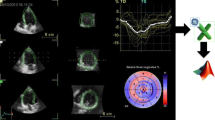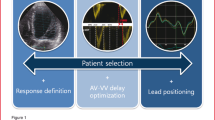Background. Mechanical dyssynchrony has proven to be superior to QRS duration in predicting response to cardiac resynchronisation therapy (CRT). Whether time to peak longitudinal strain delay between the mid-septum and mid-lateral left ventricular wall better predicts CRT response than tissue Doppler imaging (TDI) is unclear. This study compares the value of the two methods for the assessment of mechanical dyssynchrony and prediction of CRT responders.
Methods. 66 clinical responders and 17 nonresponders to CRT with severe systolic heart failure (LVEF <35%), New York Heart Association classification III or IV and a wide QRS >130 ms with left bundle branch block were evaluated by peak longitudinal strain and TDI. Doppler echocardiograms and electromechanical time delay (EMD) intervals were acquired before and after pacemaker implantation.
Results. In all responders EMD measured by peak longitudinal strain was >60 ms before implantation, compared with 76% of the patients measured by TDI. Nonresponders had EMD <60 ms measured by both techniques. Only peak longitudinal strain delay showed shortened values in every responder postimplantation and demonstrated the most significant reduction and could predict responders to CRT. However, EMD measured by TDI did not diminish in 30% of the positive clinical responders. Nonresponders showed worsening of the EMD with peak longitudinal strain, but not with TDI.
Conclusions. Responders to CRT can be excellently predicted if EMD before implantation determined by peak longitudinal strain delay is >60 ms. Peak longitudinal strain delay appears to be superior to TDI to predict the response to CRT. (Neth Heart J 2010;18:574–82.)



Similar content being viewed by others
References
Auricchio A, Stellbrink C, Sack S, et al. The Pacing Therapies for Congestive Heart Failure (PATH-CHF) study: rationale, design and endpoints of a prospective randomized multicenter study. Am J Cardiol. 1999; 83:130D–135D.
Cazeau S, Leclerq C, Lavergne T, et al. Effects of multisite biventricular pacing in patients with heart failure and intraventricular conduction delay. N Engl J Med. 2001;344:873–880.
Abraham WT, Fisher WG, Smith AL, et al. Cardiac resynchronization in chronic heart failure. N Engl J Med. 2002;346:1845–1853.
Bristow CR, Saxon LA, Boehmer J, et al. Cardiac resynchronization therapy with or without an implantable defibrillator in advanced chronic heart failure. N Engl J Med. 2004;350:2140–2150.
Higgins SL, Hummel JD, Niazi IK, et al. Cardiac resynchronization therapy for the treatment of heart failure in patients with intraventricular conduction delay and malignant ventricular tachyarrhythmias. J Am Coll Cardiol. 2003;42:1454–1459.
Fried AG, Parker AB, Newton GE, et al. Electrical and hemodynamic correlates of the maximal rate of pressure increase in the human left ventricle. J Card Fail. 1999;5:8–16.
Xiao HB, Roy C, Gibson DG. Nature of ventricular activation in patients with dilated cardiomyopathy: evidence for bilateral bundle branch block. Br Heart J. 1994;72:167–174.
Kass DA. Predicting cardiac resynchronization response by QRS duration: the long and short of it. J Am Coll Cardiol. 2003;42:2125–2127.
Achilli A, Sassara M, Ficili S, et al. Long-term effectiveness of cardiac resynchronization therapy in patients with refractory heart failure and narrow QRS complex. J Am Coll Cardiol. 2003;42:2117–2124.
Turner MS, Blaesdale RA, Vinereanu D, et al. Electrical and Mechanical components of dyssynchrony in heart failure patients with normal QRS duration and left bundle branch block: impact of left and biventricular pacing. Circulation. 2004;109:2544–2549.
Leclerq C, Faris O, Tunin R, et al. Systolic improvement and mechanical resynchronization does not require electrical synchrony in the dilated failing heart with left bundle-branch block. Circulation. 2002;106:1760–1763.
Bleeker GB, Schalij MJ, Molhoek SG, et al. Relationship between QRS duration and left ventricular dyssynchrony in patients with end-stage heart failure. J Cardiovasc Electrophysiol. 2004;15:544–549.
Sutherland GR, Hatle L, Claus P, et al. Normal regional strain rate / strain curves. In: Doppler Myocardial Imaging a Textbook. BSWK bvba, Hasselt, Belgium 2006, Chapter 4: p.68–76.
Bax JJ, Molhoek SG, van Erven, et al. Usefulness of myocardial tissue Doppler echocardiography to evaluate left ventricular dyssynchrony before and after biventricular pacing in patients with idiopathic dilated cardiomyopathy. Am J Cardiol. 2003:91:94–97.
Bax JJ, Marwick TH, Molhoek SG, et al. Left ventricular dyssynchrony predicts benefit of cardiac resynchronization therapy in patients with end stage heart failure before pacemaker implantation. Am J Cardiol. 2003;92:1238–1240.
Yu CM, Fung WH, Lin H, et al. Predictors of left ventricular reverse remodeling after cardiac resynchronization therapy for heart failure secondary to idiopathic dilated or ischemic cardiomyopathy. Am J Cardiol. 2003;91:684–688.
Sógaard P, Egeblad H, Kim Y, et al. Tissue Doppler Imaging improved systolic performance and reversed left ventricular remodeling during long-term cardiac resynchronization therapy. J Am Coll Cardiol. 2002;40:723–730.
Soliman Ol, Theuns DA, Geleijnse ML, et al. Spectral pulsedwave tissue Doppler imaging lateral-to-septal delay fails to predict clinical or echocardiographic outcome after cardiac resynchronization therapy. Europace. 2007;9:113–118.
De Boeck BW, Meine M, Leenders GE, et al. Practical and conceptual limitations of tissue Doppler imaging to predict reverse remodeling in cardiac resynchronisation therapy. Eur J Heart Fail. 2008;10:281–290.
Chung Es, Leon AR, Tavazzi L, et al. Results of the predictors of response to CRT (Prospect) trial. Circulation. 2008;117:2608–2616.
Ansalone G, Giannantoni P, Ricci R, et al. Doppler Myocardial Imaging to evaluate the effectiveness of pacing sites in patients receiving biventricular pacing. J Am Coll Cardiol. 2002;39:489–499.
Sógaard P, Egeblad H, Pedersen AK, et al. Sequential versus simultaneous biventricular resynchronization for severe heart failure. Evaluation by Tissue Doppler Imaging. Circulation. 2002;106:2078–2084.
Schiller NB, Shah PM, Crawford M, et al. Recommendations for quantification of the left ventricle by two-dimensional echocardiography. J Am Soc Echocardiogr. 1989;2:358–367.
Abd El Raman MY, Hui W, Yigitbasi M, et al. Detection of left ventricular asynchrony in patients with right bundle branch block after repair of Tetralogy of Fallot using tissue Doppler imaging derived strain. J Am Coll Cardiol. 2005;45:915–921.
Kukulski T, Jamal F, D’Hooge J, et al. Acute changes in systolic and diastolic events during clinical coronary angioplasty: a comparison of regional velocity, strain rate, and strain measurement. J Am Soc Echocardiogr. 2002;15:1–12.
Popović ZB, Grimm RA, Perlic G, et al. Noninvasive assessment of cardiac resynchronization therapy for congestive heart failure using myocardial strain and left ventricular peak power as parameters of myocardial synchrony and function. J Cardiovasc Electrophysiol. 2002;13:1203–1208.
Breithardt OA, Stellbrink C, Herbots L, et al. Cardiac resynchronization therapy can reverse abnormal myocardial strain distribution in patients with heart failure and left bundle branch block. J Am Coll Cardiol. 2003;42:486–494.
Yu CM, Fung JW, Zhang Q, et al. Tissue Doppler imaging is superior to strain rate imaging and postsystolic shortening on the prediction of reverse remodeling in both ischemic and nonischemic heart failure after cardiac resynchronization therapy. Circulation. 2004;110:66–73.
De Boeck BW, Teske AJ, Meine M, et al. Septal rebound stretch reflects the functional substrate to cardiac resynchronisation therapy and predicts volumetric and neurohormonal response. Eur J Heart Fail. 2009;11:863–871.
Author information
Authors and Affiliations
Rights and permissions
About this article
Cite this article
Scheffer, M., van Dessel, P., van Gelder, B. et al. Peak longitudinal strain delay is superior to TDI in the selection of patients for resynchronisation therapy. Neth Heart J 18, 574–582 (2010). https://doi.org/10.1007/s12471-010-0838-6
Published:
Issue Date:
DOI: https://doi.org/10.1007/s12471-010-0838-6




